What is Sales Efficiency And How to Improve it (Tips + Metrics)
Get the latest tips and advice on how to measure and improve your sales efficiency. In this post, you will find all the metrics and guidelines you need to follow to create an efficient sales team.
— Propoze
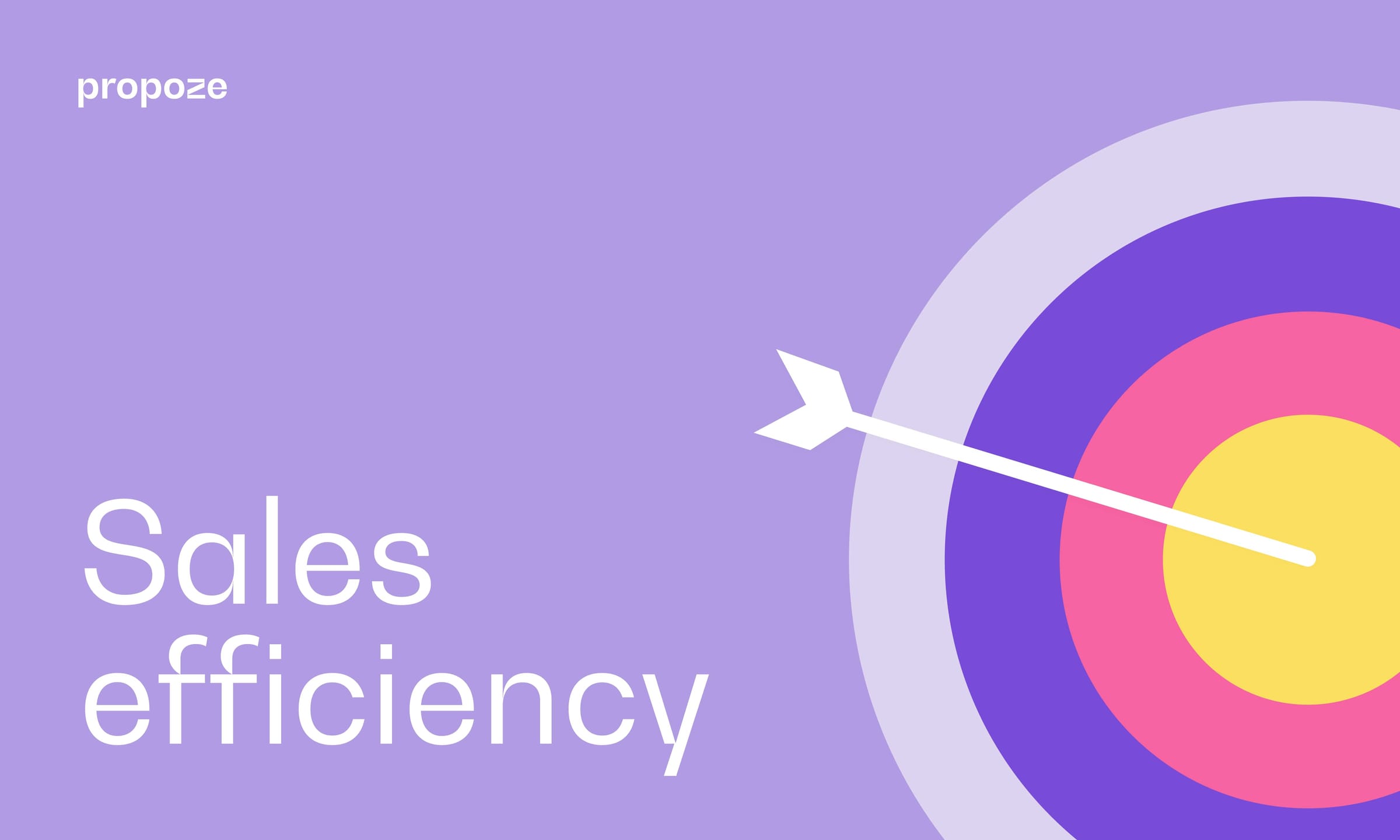
You've taken the time to plan out your sales strategy, you've set your goals and created a tactical plan your sales reps can easily follow.
The time has come to start with all the sales activities, but not everything is going according to plan. Your sales efficiency doesn't seem to be skyrocketing and your ambitious plans seem to be failing.
Luckily, this means there is room for improvement. And that's why we're here.
In this article, you'll learn about:
- how to use sales efficiency metrics
- how to achieve a great sales efficiency ratio
- what is the difference between sales efficiency and effectiveness
- actionable strategies for improving your sales efficiency
Without further ado, let's dive in.
What is sales efficiency?
Here's a short definition:
Sales efficiency is a measure of how effectively a company's sales team generates revenue relative to the invested resources.
It is a crucial metric every single business needs to measure when looking to maximize profits.
In other words, sales efficiency is about getting the most out of your sales representatives and invested resources. From making sure they are following the latest best practices and strategies to ensuring they do it quickly and don't waste time.
When broken down into numbers, sales efficiency tells you how good your sales reps are and how cost-effective your current sales strategy is.
Here are several reasons why your sales team should be laser-focused on increasing sales efficiency.
Why is sales efficiency important?
We can already agree that sales efficiency is a crucial metric for any business looking to get increase its profit margin.
But how exactly does a company's sales efficiency impact the business overall? Here's the answer.
Get the most sales possible with the current level of resources
If your sales and marketing teams are well-aligned and are using their resources effectively, there's a good chance your sales efficiency metrics are looking good.
However, you'll need to ensure that all individual sales reps are doing the best work they can.
If you're a sales manager or you're simply overseeing your sales team's efficiency, you have a wide range of options to choose from. From helping your team identify the right prospects and teaching them the best sales tactics, to enriching their toolkit with new sales tools.
The more you can reduce costs and increase the actual revenue, the more your sales efficiency metrics are going to rise.
Increase business revenue and promote growth
It's no secret that better sales processes and increased company's sales efforts equal more new business revenue.
So, can you achieve better sales efficiency and attract new customers without increasing your sales and marketing costs?
Absolutely yes!
And further into the blog post, you'll learn how to boost sales efficiency and supercharge your sales operations by maximizing efficiency of your sales teams.
Deliver a positive customer experience
In the end, it's customer satisfaction that counts and plays the biggest role in the success of your company.
If your sales processes are more efficient, this has a direct impact on customer experience - and it's a positive impact.
Also, better customer experience has a direct revenue impact, because:
- Your customers are increasingly loyal to your company
- You're getting a ton of word-of-mouth referrals
In any case, there's no reason to not look into your sales efficiency score and start improving what you can. If you're looking to achieve sustainable growth and maximize your profits, tracking sales efficiency is a must.
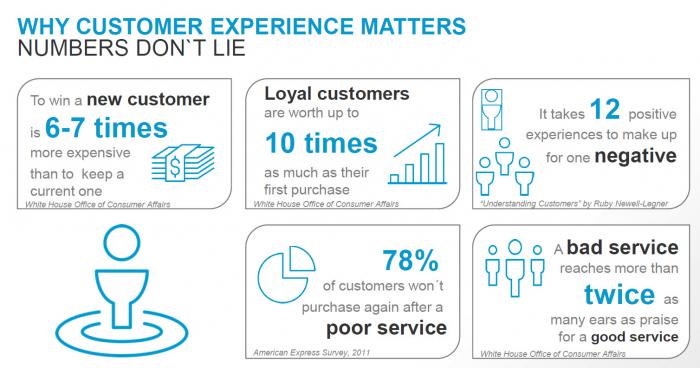
But don't just take our word for it. Here's an awesome visual from ARIS Community on why customer experience matters. As they say - the numbers don't lie.
Sales efficiency vs sales effectiveness
You may have mistaken one for another, but sales efficiency and effectiveness are not the same. Here's a quick breakdown of their key differences.
So, sales efficiency is about generating the most revenue with minimal resources. It measures how effectively your team is using time, energy, and resources to increase sales revenue.
Sales effectiveness measures how well your team is meeting its goals and objectives. In this case, you'll be tracking how well your sales reps can close new deals, meet sales quotas, and achieve other KPIs you've defined.
We can see some similarities in these two measures, but their differences too. In essence, they measure different aspects of your process.
What we can say now that we know the difference between sales efficiency and sales effectiveness:
- A highly efficient sales process generates more revenue with fewer resources
- A highly effective sales team confidently reaches its goals and objectives
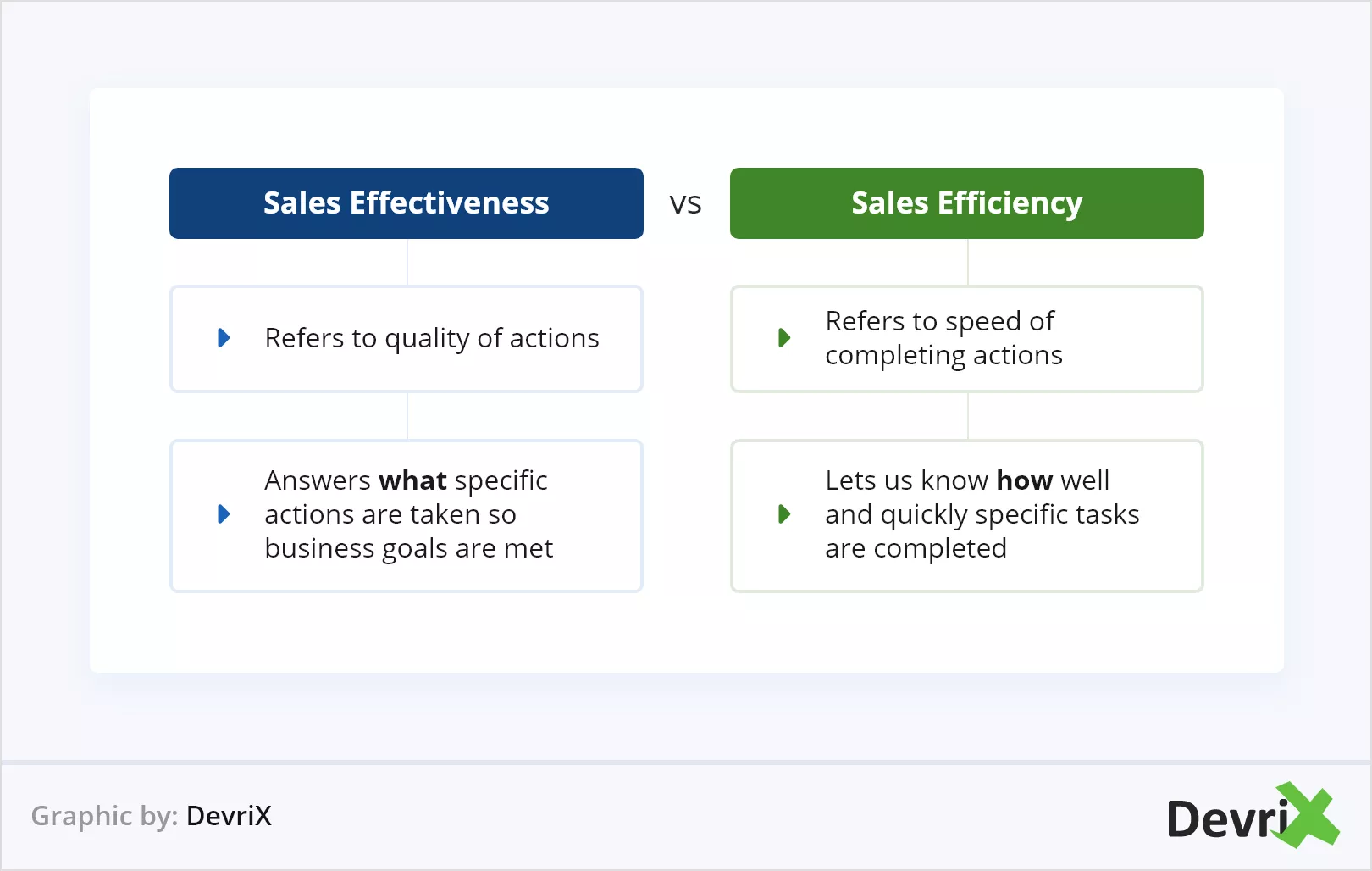
Here's a quick comparison by DevriX.
Ideally, you'll want to achieve both of these scenarios. So, let's take a look at what a solid sales efficiency ratio looks like.
How does a good sales efficiency ratio look like
It's hard to say, but a good sales efficiency ratio depends on a wide range of factors like - your industry, your business model, sales cycle length, and more.
However, there are some general guidelines we can follow.
High gross sales efficiency ratio
This ratio tells us that you're generating a huge amount of revenue relative to the invested resources. If the ratio is 3:1 or higher, that is generally considered good in many industries.
This may vary depending on your circumstances, but this kind of ratio is not easy to achieve and if you did achieve it - your team is awesome.
Short sales cycle length
Having a short cycle length indicates that your sales process is efficient.
In other words, your sales managers and reps are closing new deals quickly and are not wasting any unnecessary resources. Kudos!
High deal size
The bigger your average deal size is, the more efficient your sales process is.
This means that your team can close huge deals and generate more annual recurring revenue with fewer resources.
To sum up, there's no success without tracking sales efficiency through some key metrics like gross and net sales efficiency ratios, cycle length, and average deal size.
Sales efficiency metrics - How to calculate sales efficiency
To calculate sales efficiency and, ultimately, achieve a high sales efficiency ratio, there are certain metrics you'll need to track.
Here are the sales metrics you need to be watching.
Calculate gross sales efficiency
Gross sales efficiency is one of the key metrics your sales organization needs to measure.
To calculate it, simply divide your total revenue by your total sales and marketing expenses.
The formula is very simple:
Gross Sales Efficiency = Revenue / Sales and Marketing Expenses
A high gross sales efficiency ratio (3:1 for example) will tell you that your reps are efficiently using their resources and have no trouble selling efficiently. They know how to generate revenue in large quantities.
Still, a high gross sales efficiency ratio doesn't always indicate that a sales process is successful.
For example, your team could be focused on closing new deals quickly, but they do so by sacrificing long-term customer relationships.
This lowers the customer's lifetime value, and that's not good news. So whenever you're measuring gross sales efficiency, make sure you view it in conjunction with other metrics so you get a big picture.
Blindly following 2-3 metrics can make you think your results are absolutely stunning, but when you zoom out a bit, a different tune plays.
Calculate net sales efficiency
Even though gross sales efficiency is a helpful metric, to increase your sales productivity, you'll need to measure net sales efficiency too.
to calculate it, divide your total revenue by your total expenses. This result is a ratio that represents the amount of revenue you generate per dollar spent.
Take note, this metric doesn't include only sales and marketing expenses, but ALL expenses.
Here's a simple formula to calculate it:
Net Sales Efficiency = (Revenue - Cost of Goods Sold) / Sales and Marketing Expenses
There are a ton of factors that influence the net sales efficiency ratio like - the quality of leads and prospects, overall team effectiveness, and more. So, be sure to always zoom out and look at the bigger picture.
Are your customers satisfied? Are new big deals coming in? Are your sales reps closing new deals in a timely manner? Can your salespeople become even better through training? What is the customer acquisition cost?
Every sales efficiency metric has its place, but once again, don't isolate them and analyze them one by one. This will only do more harm in the long run than it would help.
Calculate sales cycle length
At its most basic level, sales cycle length represents the total number of days it takes for a deal to close, divided by the total number of closed deals.
And if you're closing your books, for example, quarterly - that should be the best parameter to measure the cycle length. Otherwise, tracking it monthly should prove to be a good method for approaching this metric.
A shorter cycle may indicate that your sales processes are efficient, but it doesn't necessarily mean that your sales are acquiring more new revenue than you have planned.
Take into account that some deals may be incredibly huge, but they take a lot of time to close.
And some deals are small, but they can be closed much faster - and they often come in greater volume.
In any case, here is a simple formula to calculate it and get you started:
Sales Cycle Length = (End Date of Sale - Start Date of Sale) + 1 / Number of Closed Deals
Try keeping track of how long it takes for larger deals to close, as well as smaller ones. You may find patterns and try to divide deals into several categories, depending on how long it takes for them to close.
This means that you could calculate the cycle length for every category of deals you define. And that will get you somewhere.

Here's a chart from Klipfolio that could be helpful for determining your sales cycle length.
A quick note. If you're looking to shorten your sales cycle, check out our guide to writing winning follow-up emails after sending a proposal. You'll know exactly what to do to get your client to move forward with the deal.
Calculate the average deal size
Calculating the average deal size can help you make new informed decisions on your strategy.
For example, you could estimate your potential new revenue based on the number of deals you expect to close. You could compare the average deal size across different sales reps or sales teams to identify top performers.
The latter will help you set new sales targets and drive your team towards new accomplishments.
In any case, this is a metric you most definitely want to track.
Here's a simple formula to calculate the average deal size.
Average Deal Size = (Total Value of Deals) / (Number of Deals)
As straightforward as they come, this metric is one of the most basic ones for a sales organization. And you should adopt it too.
Keep in mind, the higher the average deal size, the more it indicates that your sales processes are efficient. Again, there are other metrics to consider in conjunction with the average deal size, so be aware of this the next time you try to measure sales efficiency.
Calculate sales conversion rate
Essentially, the sales conversion rate is a metric that measures how many potential customers (leads) took action (purchase) after interacting with your salespeople.
You can calculate it easily with this simple formula:
Sales Conversion Rate = (Number of Sales) / (Number of Leads) x 100%
By calculating the sales conversion rate, you'll be a few steps closer to understanding how your leads are converting into customers.
For example, if your sales conversion rate is low, you could try refining your lead nurturing process and improving the quality of leads.
And if your sales conversion rate is high, you can use this info to replicate this tactic and start scaling.
Calculate sales team performance metrics
In addition to the above metrics, tracking individual sales performance metrics can help you identify new areas for improvement, as well as identify the top performers in your team.
For example, some individual performance metrics you could track are:
- Number of sales calls
- Number of sales emails
- Customer acquisition cost
- Number of proposals sent
- Number of meetings scheduled
- Number of deals closed
- Average deal size
- Win rate
Of course, there is a ton of metrics you can employ here, but it can easily get out of control.
You can use as many individual performance metrics, as long as you can keep your eyes on the big picture.
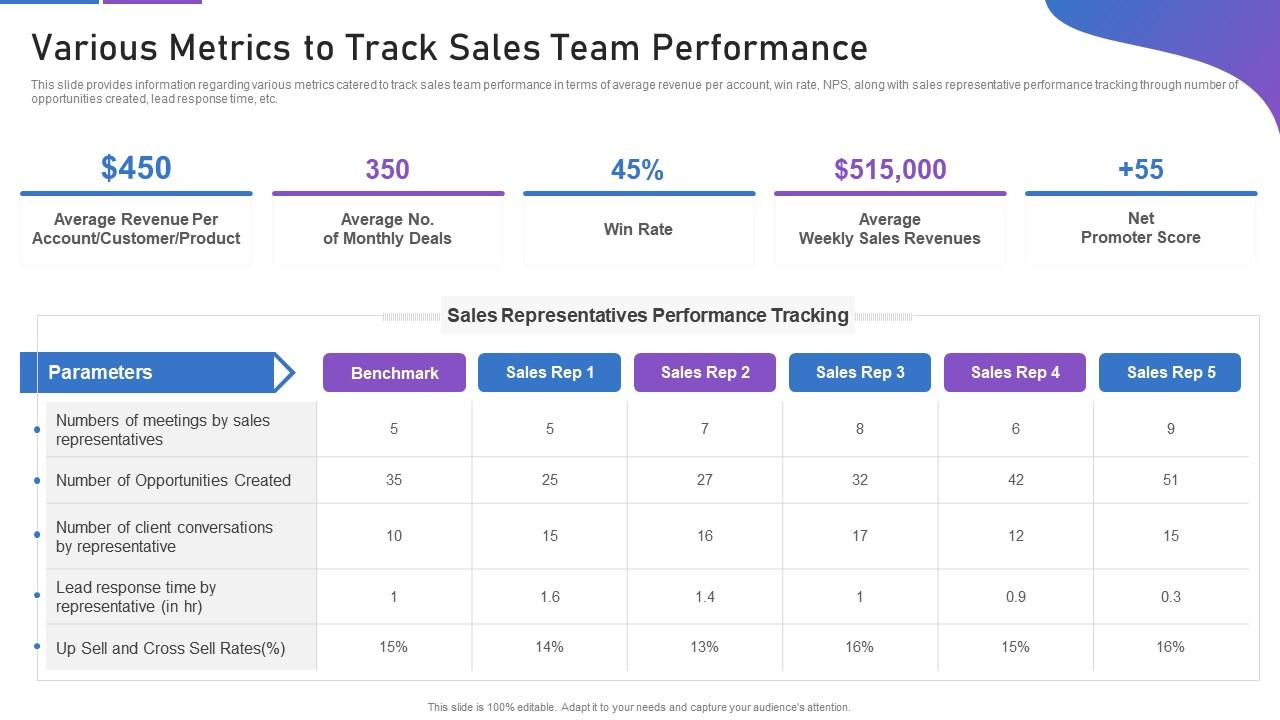
Here's a good template from SlideTeam for tracking your team's efficiency. There's a ton of templates to choose from on the internet, but they all come down to something like this in the image above.
SaaS magic number calculation
If you're representing a SaaS (software-as-a-service) company, you'll want to keep track of the SaaS magic number.
In short, the SaaS magic number is a metric that measures the efficiency of a SaaS company's sales and marketing efforts. The calculation is simple - it shows how much revenue you're generating for every dollar you've invested in the sales and marketing team.
To calculate the SaaS magic number, you'll need to take the difference between the current period's revenue and the previous period's revenue - and divide that by the total sales and marketing spend.
The result represents the amount of revenue generated per dollar spent.
If your SaaS magic number is greater than 1 - the company is generating more revenue than it is spending on sales and marketing.
If the SaaS magic number is lower than 1 - the company is spending more than it's earning. Simple as that.
In this scenario, you'll want to ensure your SaaS magic number is above 1 as much as it can be. The higher it is, the more efficient your company is at sales, but make sure you use other metrics too to evaluate your company's sales and marketing efforts.
For example, you'll want to track metrics like customer acquisition cost (CAC) and customer lifetime value (LTV) to get the big picture of your company's performance.
All in all, the SaaS sales efficiency number is a great tool for measuring your company's profitability and growth.
And here's the formula for the SaaS sales efficiency calculation:
SaaS Magic Number = (Revenue Growth Rate * Gross Margin) / Sales and Marketing Expenses
To increase your SaaS magic number, it would be great to think about implementing new marketing strategies and investing in your sales enablement efforts.

When you finish calculating your SaaS magic number, check in which category your score falls and act accordingly.
In the next chapter, find out which sales efficiency measures to implement if you have a low sales efficiency number.
How to improve sales efficiency?
To improve sales efficiency, you'll need to understand your buyers, create and follow a sales process, standardize sales onboarding, use sales tools, and track team performance.
It's pretty straightforward and the improvement process works as is, so let's get into it.
#1 Understanding your buyers
The best way to improve sales efficiency is to invest in buyer research. The more you understand your buyers, the better sales enablement strategy you can create.
This includes understanding:
- Customer needs
- Customer preferences
- Customer pain points
- Customers buying behavior
Now, to understand your buyers, the first step is to conduct market research. In this case, you'll want to:
- Analyze customer data
- Conduct customer surveys
- Gather feedback from existing customers
- Study competitors' customer experience
Once you have a clear picture of who your customers are, you can use that information to craft new sales and marketing strategies and tailor your messaging.
In the end, this will result in activating different sales channels, adjusting your pitch to focus on your customers' specific pain points, and personalizing your communication for your target audience.
Over time, you'll want to build lasting relationships with your customers and create a solid retention strategy. All this, over time, will help you build a well-oiled sales machine.
#2 Creating and following a sales process
The next strategy for improving sales efficiency is creating and following a well-defined sales process.
In short, the sales process is a series of steps your team needs to take to move a prospect from the initial contact phase to closing the deal. If your team is closely following the defined process, you'll be sure to know they are working efficiently and are wasting no time and effort.
To create such an efficient process, you need to start with your current one.
Map out each step of your sales process, try to identify all bottlenecks and inefficiencies, and gather as much feedback from your team as possible.
Here, you'll be asking your team questions like:
- What are the current pain points in our process?
- Which customer complaints repeat the most?
- What sales tactics proved to be the most successful?
Here's some help! Read our guide on how to design a sales pipeline and establish highly-efficient sales processes.
Once you identify areas of improvement, you should immediately start creating a new, more efficient process. Here's how to do it:
- Define clear stages and milestones, each stage of the process needs to have clear goals, objectives, and appropriate metrics.
- Establish standard procedures and guidelines like standardized sales scripts and outline specific actions your team members need to take at each stage of the process.
- Leverage technology and automation to streamline the process. For example, try automating lead scoring, email nurturing, and proposal creation tasks.
- Regularly gather feedback and track key metrics to identify areas for improvement and refine the process continuously.
It may seem straightforward and easy to implement, but creating a new process is a daunting task that requires maximum focus. Try working together with your team to create a process all team members can easily follow and execute.
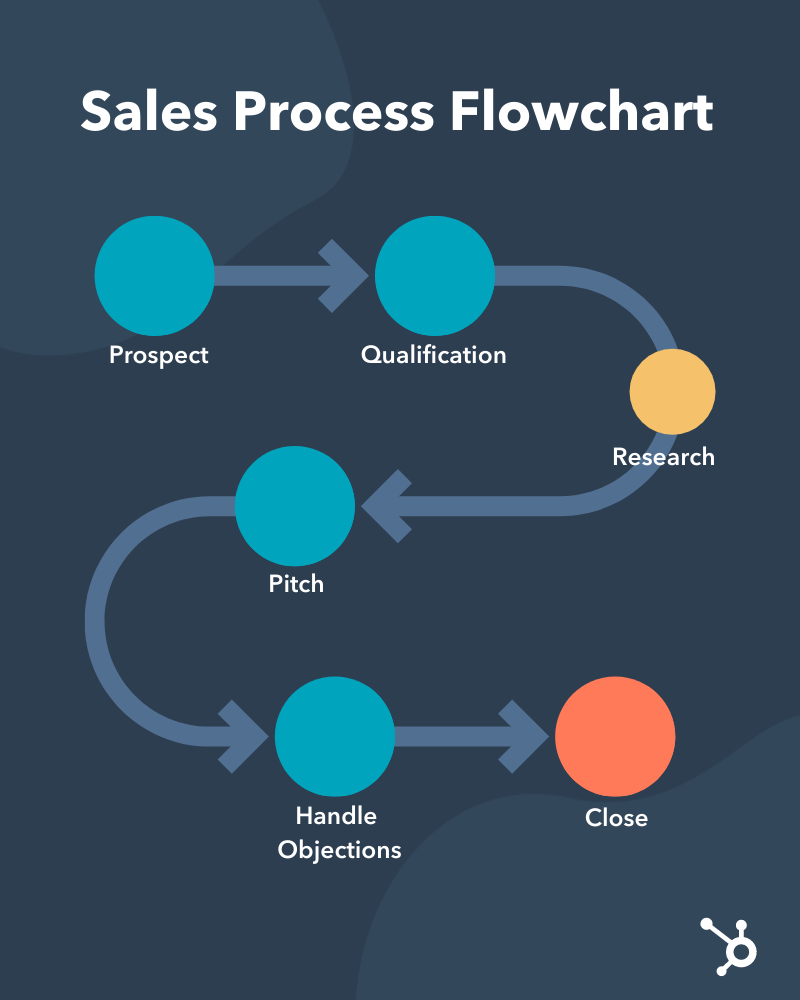
Here's a chart from HubSpot on how a sales process should look like. Also, check out their guide to creating a sales process, you'll definitely find it useful!
#3 Standardization of sales onboarding
There is a huge chance you'll be hiring new sales reps over time. When you do, you'll want to have a standardized onboarding process for your new hires.
This helps you ensure new team members can easily integrate into your team and get all the tools and information they need to succeed.
Here's what to consider when standardizing your sales onboarding:
1) Develop a comprehensive onboarding plan
In this onboarding plan, try to outline all the training and resources your new sales hires will receive. Also, include a timeline for onboarding.
2) Create a sales playbook
This is your team's insider sales information. In this playbook, try to outline your entire sales process. Also, outline your sales messaging, include sales scripts, and go into detail on all the best practices you want your team to follow.
Creating such a playbook will help both new and existing team members to refresh their memory and keep their eyes on the big picture.
3) Provide coaching and continuous feedback
Through sales coaching and regular feedback, you can help your team learn and improve quickly. Be it one-on-one coaching sessions or regular performance reviews, make sure you take any opportunity to help your team members improve.
By standardizing your sales onboarding process, your new team members can quickly get up to speed with all your latest sales practices.
This is one of the best ways to enhance sales efficiency and reduce the risk of hiring.
#4 Using sales tools
Using sales tools is one of the key ingredients to improving sales efficiency.
The use of such tools can help you automate time-consuming tasks, free up time for your team, and help you realign with your strategic goals and initiatives.
Here are some tools you may want to check out:
1) CRM (customer relationship management) software
If you're leading a team of sales professionals, chances are you are already using CRM software in your day-to-day activities. From managing leads, and tracking customer interactions, to automating tasks like following up with prospects - there is a myriad of activities you can execute with CRM.
Some most popular CRM currently on the market are HubSpot and Salesforce. Be sure to try them out if you still haven't had the chance.
2) Sales enablement tools
Sales enablement tools are a bit different from CRM. They help you create and share content with prospects, and track the engagement with that content. These tools act as repositories for sales content, pitch decks, playbooks, scripts, and other sales collateral.
HubSpot Sales Hub, Seismic, and Highspot are one of the best-rated sales enablement software at the moment. Be sure you check them out if you still haven't tried any of them and start creating your sales enablement program as soon as possible.
3) Proposal management tools
Proposal management tools are a must-have in your sales toolkit. They help you simplify the proposal process and make it easy to create new sales proposals. Regardless of the product or service you're offering, sales proposal tools can 5X your proposal creation process.
If you still haven't, try using Propoze! If you're looking to quickly create a simple, beautiful sales proposal, Propoze is your go-to tool.
By using the sales tools we've just mentioned, you can gather and analyze an enormous amount of sales data and automate countless tasks. The better you prepare your team to work efficiently, the more you can improve your overall sales efficiency and increase the amount of business revenue generated.
Quick note - here's the link to our buyer's guide to proposal management tools. Choose the best one for your team and cut the time your reps spend on administrative tasks.
#5 Tracking sales team performance
If you're not tracking the performance of your team, it's going to be hard to better your sales efficiency at all.
By monitoring the performance of your individual sales reps and your team as a whole, you can easily spot new areas for improvement and come up with new strategies that can skyrocket your sales effectiveness.
Here's how you can do it:
1) Clearly define sales performance metrics
The first thing you can do is analyze your current efforts and results, set new sales goals, and define KPIs for your team.
These KPIs (key performance indicators) can be conversion rates, incremental revenue generated, or average deal size. Keep in mind, whichever metric you set as your KPI needs to be specific, measurable, and closely related to your business goals.
A good goal-setting framework you should check out, in this case, is the SMART goal framework.
2) Use a sales dashboard
When using one of your numerous sales tools, it's a good practice to create a unified sales dashboard that can provide you with a real-time overview of your team's performance.
For example, if you're managing 10 salespeople, you'll want to have a single dashboard where you can see how many calls they made, how many sales they generated in the last week, how close are they to reaching their goals, and so on.
From here on, it will be easy to discover different result patterns and find out exactly which things need to be improved. For instance, one of your team members could have a problem with too long sales calls that often end up unsuccessfully.
In this case, you could instruct that team member to shorten their calls if they see they won't have much success on that particular call. But how will they know when to do that? And how will they do that?
That's why we talked about creating a sales playbook and investing in sales onboarding. Make sure your team knows what they need to do, when they need to do it, how to do it, and finally - why they need to do it. This applies to various sales situations.
3) Conduct regular performance reviews
By introducing regular performance reviews, you can help your sales team understand in what areas are they excelling and in which they are underperforming.
During these performance reviews, you can help your team set new goals that reflect their current results and impart some of your sales knowledge and experience to them.
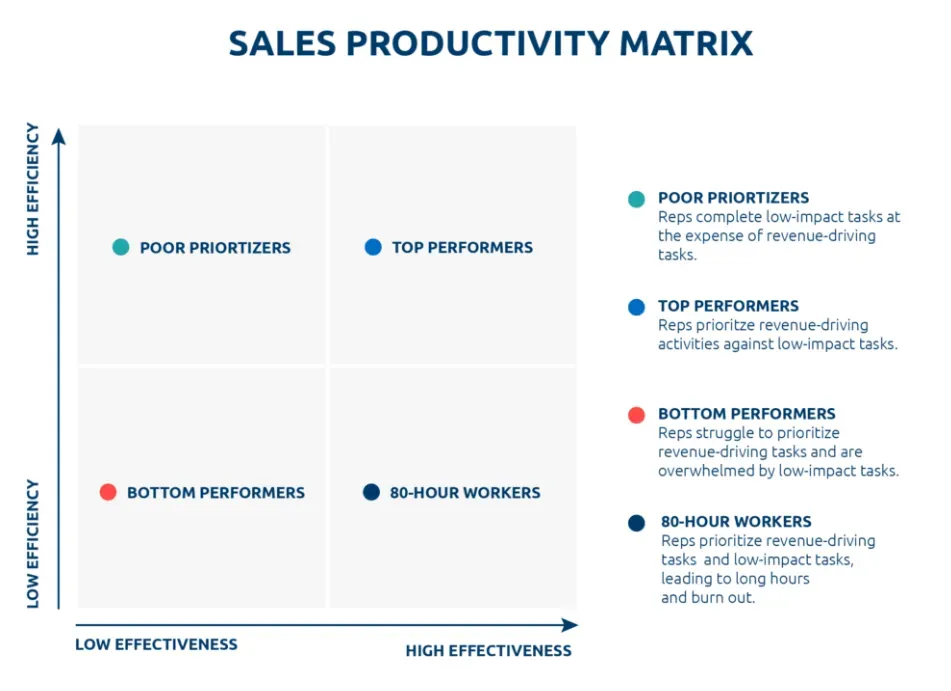
Here's a sales productivity matrix by salesman.com on how to categorize your team members by performance.
Ideally, you should strive to hire top performers or train and improve your team until they reach the "top performer" status.
4) Organize a sales contest
When working in sales, it's healthy to have a bit of a competitive environment that drives your performance. This will, with no doubt, motivate your team members.
Important to know when organizing a sales contest - clear rules and goals need to be set, and the prizes need to be defined from the start.
To sum up this large chapter - tracking your sales team's performance is the best course of action you can take when managing a team of professionals. The benefits are good and plenty and all that is left for you is to immediately start without any hesitation.
Use Propoze to close more sales for free
Indeed, this was a long read, but we've got a bit more before you depart.
We talked about sales tools earlier, but we've barely mentioned our own sales tool! Propoze is a sales proposal software (with a free plan) that will help you get your proposals done quickly and easily.
You can create your own proposal templates, set and edit your pricing units and services, and close deals with a single click from your prospect.
The good thing is that we have a free plan if you're still a bit indecisive. So, give it a try and let us know what you think! We're continuously improving and adding new features, so let us know which feature you would like to see in the next version!
Check our pricing plans on this link.
And if you have any sales-related questions on calculating sales efficiency or improving it, please don't hesitate to contact us at support@propoze.app!
Follow us on our LinkedIn, Twitter, and Instagram accounts! We post regularly on proposal and sales-related topics.